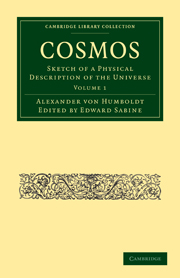III - CULTURE OF CHARACTERISTIC EXOTIC PLANTS
from INCITEMENTS TO THE STUDY OF NATURE: General Remarks
Published online by Cambridge University Press: 05 August 2011
Summary
The effect of landscape painting, notwithstanding the multiplication of its productions by engravings and by the modern improvements of lithography, is still both more limited and less vivid, than the stimulus which results from the impression produced on minds alive to natural beauty by the direct view of groups of exotic plants in hot-houses or in the open air. I have already appealed on this subject to my own youthful experience, when the sight of a colossal dragon tree and of a fan palm in an old tower of the botanic garden at Berlin, implanted in my breast the first germ of an irrepressible longing for distant travel. Those who are able to reascend in memory to that which may have given the first impulse to their entire course of life, will recognise this powerful influence of impressions received through the senses.
I would here distinguish between those plantations which are best suited to afford us the picturesque impression of the forms of plants, and those in which they are arranged as auxiliaries to botanical studies; between groups distinguished for their grandeur and mass, as clumps of Bananas and Heliconias alternating with Corypha Palms, Araucarias and Mimosas, and moss-covered trunks from which shoot Dracontias, Ferns with their delicate foliage, and Orchideæ rich in varied and beautiful flowers, on the one hand; and on the other, a number of separate low-growing plants classed and arranged in rows for the purpose of conveying instruction in descriptive and systematic botany.
- Type
- Chapter
- Information
- CosmosSketch of a Physical Description of the Universe, pp. 92 - 100Publisher: Cambridge University PressPrint publication year: 2010First published in: 1846

